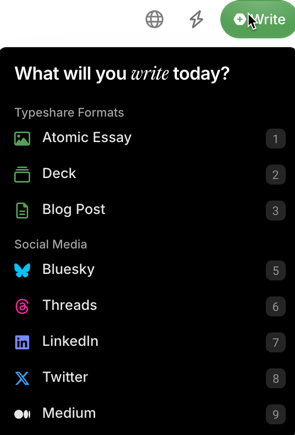Everything in life follows a formula. Someone, somewhere has already done what you want to do—and they’ve likely repeated their success using a proven template. We hear phrases like:
- “Imitation is the most sincere form of flattery.”
- “Steal like an artist.”
- “Don’t reinvent the wheel.”
Yet, because we fear being unoriginal, we often try to go out on our own. But the secret to creativity isn’t avoiding structure—it’s recognizing patterns and making them your own. Learning how to identify these patterns and document them can revolutionize your writing process.
The Power of Templates
Templates are everywhere. In fact, services like Typeshare.co are built around providing content creation templates for writers. You pick a template, add your unique spin, and publish. Fresh templates are added weekly to keep content engaging and dynamic.

And chances are, you’re already using templates in some form:
- Reusing AI prompts that yield great results with ChatGPT or Claude
- Writing justification memos at work for purchases or promotions
- Using canned email responses for common inquiries
How to Build Your Own Story Writing Templates
You can create your own powerful story writing template library once you start seeing these patterns. Let’s develop a storytelling template based on insights from Philipp Humm’s excellent storytelling video that has drawn hundreds of thousands of viewers.
Storytelling Steps:
- Location – State where you are. The best stories establish a setting right away.
- Actions – Describe what is happening in the moment. Zoom in on the action and avoid unnecessary context.
- Thoughts – Share raw, authentic thoughts that make the moment relatable.
- Emotions – Show how you felt, both physically and emotionally.
- Dialogue – Use concise, catchy, and memorable dialogue to bring the scene to life.
A Template You Can Use Right Now
Title: Hook Your Reader Immediately
In [time/date], I was [at a specific location]. I was [zoom into the most important action; what was happening?].
I remember thinking, [raw, honest thoughts]. I could feel [describe physical sensations, emotions]. It was as if [more descriptive words or an action/setting change to set up dialogue].
Person A said, [concise, catchy phrase]. So I, [action, dialogue, feeling, or thought to extend tension].
And I just remember, [feeling, thinking, learning to resolve the tension and hit the point home]. It reinforced for me that [the takeaway].
Here’s My Example Using the Template

The Day He Won’t Remember, But I’ll Never Forget
Last summer, my son came into the kitchen, took a seat while I cleaned up, and a spontaneous conversation about art, life, politics, and love began.
I remember looking at him in wonder as he told me stories of college life. How had he become this grown man sitting in front of me? I could feel tears welling up inside—not from sadness but from overwhelming love and gratitude. I had a deep knowing that this was “a moment,” and I needed to be fully present. Time slowed… I wanted his every word to linger in the air. I observed his posture shifts, the expression in his eyes as he spoke with conviction. I was having an ethereal, out-of-body experience, watching this beautiful, unlimited human so freely sharing his life with me.
It might have been an hour or two before it ended naturally. The details are fuzzy. I think we went to Chick-fil-A to get some dinner. It was just another day for him. But for me, it is a moment I will never forget.
Your Turn: Start Building Your Template Library Today

The most successful creators don’t start from scratch—they build on proven foundations. As Mel Robbins writes in her book, The Let Them Theory:
“Formulas exist because they work time and time again. You will make it unique because you will be putting yourself into the formula. Do not reinvent the wheel. Follow the formula and use it to your advantage.”
Here’s How to Begin:
- Become a Formula Detective: Start noticing patterns in content that moves you. What structure does it follow? How does it begin and end?
- Create a Template Repository: Set up a digital notebook or database (Notion, Evernote, or even a simple Google Doc) dedicated to your growing template collection–whether story writing templates, blog post generators, or any other type of writing you repeat.
- Test and Refine: Use your templates and adjust them based on results. The best templates evolve over time.
- Share Your Templates: Consider building a community around your best templates—they’re incredibly valuable to others in your field.
Templates don’t limit creativity—they amplify it. By recognizing patterns and structuring your ideas, you create a strong foundation that allows your unique voice to shine through.
Additional Resources:
- David Hutchens’ free StoryMap: https://www.davidhutchens.com/
- Philipp Humm’s storytelling video: Watch on YouTube
- Hooks for Stories: Examples
Now it’s your turn—what template will you create today? ✨
